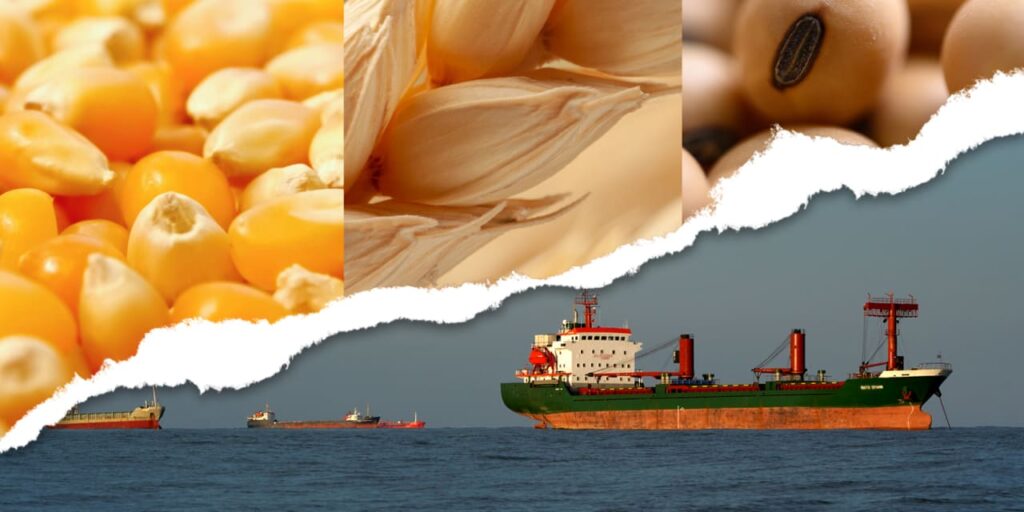Grain prices have declined sharply this year, but analysts predict that demand for corn and soybeans may improve in the months ahead, while supplies of wheat may tighten.
Corn futures recently hit their lowest price in nearly three years, while wheat and soybean futures fell to their lowest settlements since 2021.
There was a lot of anticipation that the U.S. would have decent corn and soybean crops this year. Because of that early view, there was money flow out of the markets with traders going from near-record net long positions to neutral or net short positions, said Stephen Nicholson, Rabobank global grains & oilseeds sector strategist.
Corn stocks, in particular, built up as demand was weak in the 2022-2023 crop year. High prices and on the feed side, liquidation of cattle because of a drought in the Southern Plains and “unprofitability” in the swine and poultry business until recently affected the stocks, he told MarketWatch.
Corn
There’s a lower demand for corn in animal feed.
The most-active corn futures
C00,
CZ23,
settled at $4.64 a bushel on Nov. 10, the lowest finish for a most-active contract since late December 2020, according to data from FactSet. At $4.70 ¾ a bushel on Wednesday, it’s down nearly 31% for the year so far.
Overall, U.S. corn has seen a “looser supply and demand situation,” said Darin Newsom, Barchart senior market analyst. Demand is rising, but “not keeping up with the increase in supplies because of better weather this growing season.”
In a November report, the U.S. Department of Agriculture forecast U.S. corn production at a record high of 15.2 billion bushels for the 2023/2024 marketing year.
A separate government agency report issued in June estimated a corn crop of 94.1 million acres, up 6% from last year, which would be the third-highest planted acreage in the U.S. since 1944.
“We [have] all been a little mystified as to how…large that corn acreage is, and it stuck through all year, but it really comes back to margins,” said Nicholson. In planning the 2023 crop, farmers saw good margins for corn and good planting weather, Nicholson said, “allowing farmers to plant a little bit more” as fertilizer prices also came down.
Looking ahead, Newsom expects corn demand for feed to increase due to a larger cattle herd, and demand for exports to rise due to available supplies.
Soybeans
Meanwhile, export demand for U.S. soybeans is “very slow” at this time, said Newsom. The U.S. is projected to export less than half of what Brazil is expected to ship, he said, though this could change if weather reduces Brazil’s 2024 crop.
In November, the USDA forecast U.S. soybean exports of 1.76 million bushels for the 2023-2024 marketing year, down from 1.99 million bushels in 2022-2023.
Despite that decline, Newsom said he believes the U.S.-China trade war has made the U.S. a big player in the global soybean market.
Crush demand for soybeans should stay strong through at least February or March because of Argentina’s “short” crop last year, and the world’s need for U.S. soybean meal, he said. Crushing refers to the process in which soybeans are processed into soybean meal, which is mostly used in animal feed and soybean oil.
Soybean futures
S00,
SF24,
settled at $12.52 ½ a bushel on Oct. 11, the lowest since mid-December 2021. At $13.85 on Wednesday, it’s lost 9.1% year to date.
Wheat
Wheat prices had also settled last month at their lowest in almost two years, on the back of ample global supplies.
Russia was a record exporter of wheat this year at “relatively cheap prices on the world market,” said Nicholson. “That put a lot of downward pressure on wheat prices for the other wheat exporters in the world to complete.”
Even without the Black Sea Grain deal in place, Russia was able to export record amounts of wheat, he said. That’s because Russia “geographically or geopolitically” is “controlling that Black Sea area, or those shipping lanes, for the most part to get…product out.”
A lot of Russia’s products go east to India and China, which have been “big buyers” of both oil and wheat from Russia, Nicholson said.
At the same time, Ukraine reportedly opened temporary shipping routes, allowing civilian ships — including those with grain shipments — to sail from its Black Sea ports after Russia withdrew in July from the grain deal brokered by the United Nations.
U.S. wheat prices declined against that backdrop. Kansas City hard red winter wheat futures
KWZ23,
settled at $6.29 ¼ a bushel on Oct. 31, the lowest since mid-July 2021. They trade nearly 28% lower year to date after settling Wednesday at $6.39 ¾.
U.S. wheat exports have been “pretty dismal” for the last couple of years because prices have been so high, said Nicholson.
However, with wheat prices coming down, we might see a bit of an increase in U.S. exports, he said, as Australia is expected to have a smaller crop this year, Russia is running out of wheat because it has exported so much, and Europe had an OK crop but it’s still a bit smaller than expected. Canada, the United States and Argentina also had smaller crops, he said.
So there’s the “possibility and potential” that in the first and second quarter of next year we “could see U.S. wheat exports come back because there just isn’t a place to get them,” said Nicholson.
Read the full article here

